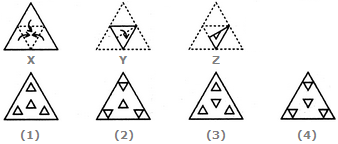Discussion
Home ‣ Non Verbal Reasoning ‣ Cubes and Dice See What Others Are Saying!
- Question
Three positions of a cube are shown in the figure. What will come on the face opposite to N?

Options- A. P
- B. Q
- C. S
- D. Z
- Correct Answer
- Z
Explanation
- 1. In the following question, among the four answer figures which one can be formed from the cut out pieces given below?
Options- A. 1
- B. 2
- C. 3
- D. 4 Discuss
- 2. What will come in place of?:

Options- A. 1
- B. 2
- C. 3
- D. 4 Discuss
- 3. In each of the following questions which of the answer figures is exactly the mirror image of the question figure when the mirror is held at the given point
Options- A. 1
- B. 2
- C. 3
- D. 4 Discuss
- 4. Which of the answer figures is exactly the mirror image of the given figure when mirror is held as shown?
Options- A. 1
- B. 2
- C. 3
- D. 4 Discuss
- 5. Find out which of the figures (1), (2), (3) and (4) can be formed from the pieces given in figure (X).

Options- A. 1
- B. 2
- C. 3
- D. 4 Discuss
- 6. A piece of paper is folded and punched as shown below. From the given responses, indicate how it will appear when opened.
Options- A. 1
- B. 2
- C. 3
- D. 4 Discuss
- 7. Find the question mark ? figure from answer figure.
Options- A. 1
- B. 2
- C. 3
- D. 4 Discuss
- 8. Choose a figure which would most closely resemble the unfolded form of Figure (Z).

Options- A. 1
- B. 2
- C. 3
- D. 4 Discuss
- 9. Choose the alternatives which is closely resembles the water image of the given combination.
Options- A. (a)
- B. (b)
- C. (c)
- D. (d) Discuss
- 10. Choose the alternatives which is closely resembles the water image of the given combination.
Options- A. (a)
- B. (b)
- C. (c)
- D. (d) Discuss
More questions
Correct Answer: 4
Explanation:
NA
Correct Answer: 2
Explanation:
All the elements moves anti clock wise.
Correct Answer: 4
Explanation:
As we know that the mirror image always be opposite the original image across the given line. Given image will become opposite to the given line xy.As shown in given below .
Correct Answer: 2
Explanation:
As per above given question figure ,
we can say that the mirror image always be opposite the original image across the given line. Given image will become opposite in mirror across the given line XY.
Correct Answer: 2
Correct Answer: 2
Explanation:
NA
Correct Answer: 3
Explanation:
The movement of designs from first figure to second figure can be shown as :
Correct Answer: 3
Correct Answer: (a)
Explanation:
Upper part will go down in opposite direction in water image.
Correct Answer: (b)
Explanation:
Upper part will go down in opposite direction in water image.
Comments
There are no comments.Programming
Copyright ©CuriousTab. All rights reserved.
